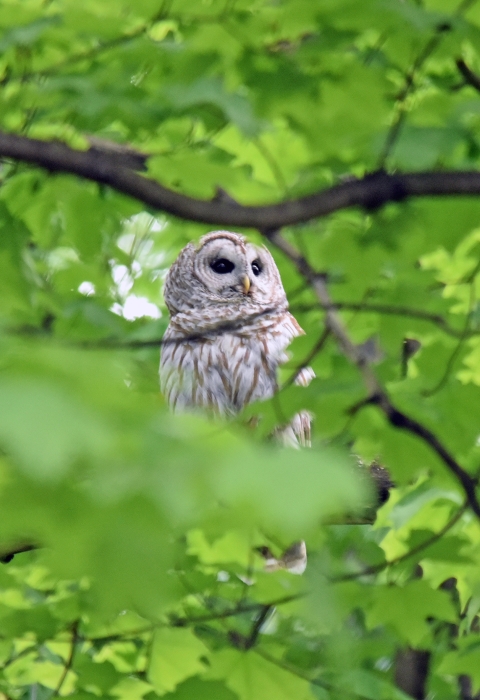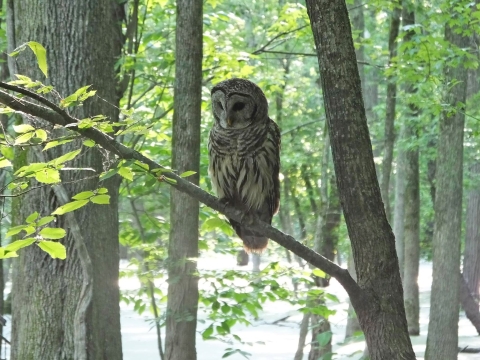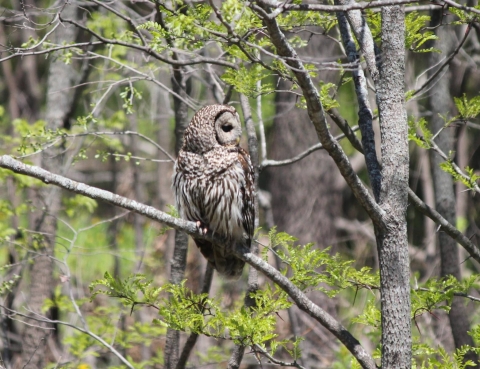Get to Know Barred Owls
While barred owls are known to reside around Minnesota Valley National Wildlife Refuge and in the state in general, they are seldom seen, as they are most active at night. Don’t let that discourage you, as barred owls will still call and hunt occasionally during the day. Most commonly located in wooded swamps or dense forests in southeast Minnesota, they can also inhabit mature coniferous, or cone-bearing, trees in northern and northwestern Minnesota. Additionally, the range of this species includes parts of the upper west coast and eastern half of the U.S., lower-eastern and lower-western Canada and Central Mexico. Typical habitats of these owls have large trees often near water, meadows or open fields.
If you’re lucky enough to spot one, how do you know it’s a barred owl? The most stand out feature of this owl species is its barring pattern. They have brown horizontal barring across their chin and brown vertical barring across their white breast and belly. Some other noticeable features are their dark eyes and yellow bill. Luckily, male and female barred owls look alike, so that leaves less confusion when it comes to identification.
Courtship Activities
As we roll through February, the month commonly associated with love and connections, barred owl courtship activities begin, leading into breeding season which lasts from March until August. While you may see some similarities with our courtship, their activities can look pretty different. Common behaviors include males and females perched close together, bobbing and bowing their heads, raising their wings and calling. It is common that males will feed the females and further display by swaying back and forth with raised wings while sidling, or moving to one side slyly, along the branch. We should take notes of these interesting courtship activities. Maybe we could learn a thing or two from them!
It is common that male and female barred owls mate for life and maintain the same nest and territory for multiple years. Sounds familiar, right? Courtship during this month is more commonly when duetting pairs would be heard, but barred owl calls can be heard year-round.
Songs and Calls
If you’ve never heard a barred owl call before then you are in for a treat. Their calls are not so similar to the stereotypical “hoo-hoo” call that many people associate with owls. Barred owls are best known for their unique vocalization and rich baritone sound. Their calls are often heard in series of eight, or also known as an eight-hooter: hoo, hoo, hoo-hoo; hoo, hoo; hoo, hooo-aw! A common phrase related to barred owl calls that you can almost hear if you listen closely is, "Who, cooks, for –you? Who, cooks, for-you, all?"
If you find yourself taking an evening or night-time hike on the refuge, listen for their distinctive call. You may be lucky enough to hear mated pairs call in a duet, but a mix of weird howls, yelps and raucous squalls or screams may surprise you. Their calls are very unique, and it could almost be unnerving if the listener doesn’t know the source of the sound. Some have said that barred owl calls sound like monkeys! Wouldn’t that be a crazy sight to see in Minnesota.
The Search Begins
As their courtship season progresses, now is great time to take a stroll through a forest to listen for barred owl calls and duets. Whether it be early in the morning or late evening after dark, many of our refuge trails are maintained during the winter and are open from 5 am to 10 pm daily. Come take a hike and checkout binoculars for free at our Bloomington Visitor Center front desk, in search of barred owls. According to some, spotting a pair or hearing a duet may even bring you good luck!




